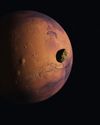
Saturn is our Solar System’s ringed wonder – a spectacular world encircled by planes of icy debris, giving it a unique appearance. But there’s a lot more to Saturn than just its rings; this enormous world is worth exploring both for its own complexity and the fascinating family of satellites that orbit it. As the most distant Solar System object easily seen with the naked eye, Saturn orbits at an average of 1.43 billion kilometres (887 million miles) from the Sun. Its slow orbit means that Saturn takes 29.5 years to make a full circuit through the constellations of the zodiac; it was this stately movement that led ancient stargazers to associate it with the father of Jupiter in Roman mythology.
Its distance makes it a challenging object for study, even in the era of giant telescopes. Most of what we know about the planet comes from the Voyager probe flybys in the 1980s and the Cassini mission that orbited between 2004 and 2017. Earth observations, coupled with close-up images from these explorers, have revealed that what often appears to be a placid orb of creamy cloud is in fact a surprisingly active world.
Internally, Saturn is a gas giant like Jupiter, a huge ball dominated by the lightweight elements hydrogen and helium. It owes its very different outward appearance to a substantially lower mass – Saturn weighs as much as 95 Earths, but this is less than a third of Jupiter. The weaker gravity allows Saturn’s upper layers to billow outwards, giving it the lowest average density of any world in the Solar System – about two-thirds that of water.
This story is from the Issue 127 edition of All About Space.
Start your 7-day Magzter GOLD free trial to access thousands of curated premium stories, and 9,000+ magazines and newspapers.
Already a subscriber ? Sign In
This story is from the Issue 127 edition of All About Space.
Start your 7-day Magzter GOLD free trial to access thousands of curated premium stories, and 9,000+ magazines and newspapers.
Already a subscriber? Sign In

MYSTERIES OF THE UNI WHERE ARE ALL THE SPIRAL GALAXIES?
There are far fewer spiral galaxies than elliptical ones in the Supergalactic Plane, and scientists are keen to discover why

ZOMBIE STARS
+10 OTHER TERRIFYING SPACE OBJECTS

HOW TO BEAT LIGHT POLLUTION
Thought it was impossible to observe the wonders of the night sky from towns and cities? Think again. Follow our tips and tricks on successfully observing through sky glow

15 STUNNING STAR CLUSTERS
These beautiful stellar groupings are spattered across the cosmos

Eileen Collins "It was a difficult mission...we were the first to see Mir"
Having served as both the first female pilot and first female commander of NASA's Space Shuttle, Collins boosted the involvement of women in space exploration to a whole new level

MARS LEAKS FASTER WHEN IT'S CLOSER TO THE SUN
The Red Planet has lost enough water to space to form a global ocean hundreds of kilometres deep

FUTURE TECH KANKOH-MARU
This ambitious reusable spacecraft will be capable of taking 50 people to and from orbit

THE FINAL FRONTIER
Beyond the reach of the Sun is a fascinating region of the cosmos that were only just beginning to explore

A long-lost moon could explain Mars' weird shape and extreme terrain
A long-lost moon could explain why Mars is so different from the other rocky planets in the Solar System. Today Mars has two tiny moons.

A sprinkling of cosmic dust may have helped kick-start life on Earth
Cosmic dust may have helped kick-start life on Earth. New findings challenge a widely held assumption that this wasn't a plausible explanation.